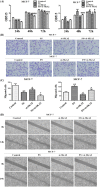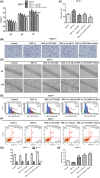The N-terminal polypeptide derived from vMIP-II exerts its anti-tumor activity in human breast cancer by regulating lncRNA SPRY4-IT1
- PMID: 30104400
- PMCID: PMC6200706
- DOI: 10.1042/BSR20180411
The N-terminal polypeptide derived from vMIP-II exerts its anti-tumor activity in human breast cancer by regulating lncRNA SPRY4-IT1
Abstract
Accumulating evidence demonstrates that long non-coding RNA (lncRNA) sprouty4-intron transcript 1 (lncRNA SPRY4-IT1) plays a vital role in the development of breast cancer. However, the underlying mechanism has not been eventually illuminated. We aimed to explore the biological activity of lncRNA SPRY4-IT1 in breast cancer cells and whether N-terminal polypeptide derived from viral macrophage inflammatory protein II (NT21MP) could exert its anti-tumor effect by regulating lncRNA SPRY4-IT1 and its target gene SKA2 Real-time RT-PCR, Western blotting, wound healing, and invasion assays were used to achieve this goal. We found that lncRNA SPRY4-IT1 was highly expressed in breast cancer cells. Moreover, NT21MP markedly inhibited biological effects of breast cancer cells by regulating lncRNA SPRY4-IT1, which was partially achieved through SKA2. Our findings suggested that lncRNA SPRY4-IT1 could serve as a novel biomarker by NT21MP for breast cancer.
Keywords: Breast cancer; NT21MP; SKA2; SPRY4-IT1.
© 2018 The Author(s).
Conflict of interest statement
The authors declare that there are no competing interests associated with the manuscript.
Figures













Similar articles
-
Long non-coding RNA SPRY4-IT1 promotes epithelial-mesenchymal transition of cervical cancer by regulating the miR-101-3p/ZEB1 axis.Biosci Rep. 2019 Jun 4;39(6):BSR20181339. doi: 10.1042/BSR20181339. Print 2019 Jun 28. Biosci Rep. 2019. PMID: 31092700 Free PMC article.
-
Overexpression of the long non-coding RNA SPRY4-IT1 promotes tumor cell proliferation and invasion by activating EZH2 in hepatocellular carcinoma.Biomed Pharmacother. 2017 Jan;85:348-354. doi: 10.1016/j.biopha.2016.11.035. Epub 2016 Nov 28. Biomed Pharmacother. 2017. PMID: 27899259
-
EZH2-mediated epigenetic suppression of long noncoding RNA SPRY4-IT1 promotes NSCLC cell proliferation and metastasis by affecting the epithelial-mesenchymal transition.Cell Death Dis. 2014 Jun 26;5(6):e1298. doi: 10.1038/cddis.2014.256. Cell Death Dis. 2014. PMID: 24967960 Free PMC article. Clinical Trial.
-
The long non-coding RNA SPRY4-IT1: An emerging player in tumorigenesis and osteosarcoma.Cell Prolif. 2018 Aug;51(4):e12446. doi: 10.1111/cpr.12446. Epub 2018 Feb 27. Cell Prolif. 2018. PMID: 29484753 Free PMC article. Review.
-
Prognostic Value of Long Noncoding RNA SPRY4-IT1 on Survival Outcomes in Human Carcinomas: A Systematic Review and Meta-Analysis with TCGA Database.Biomed Res Int. 2020 Nov 1;2020:5868602. doi: 10.1155/2020/5868602. eCollection 2020. Biomed Res Int. 2020. PMID: 33204703 Free PMC article.
Cited by
-
LncRNA SPRY4-IT1 regulates breast cancer cell stemness through competitively binding miR-6882-3p with TCF7L2.J Cell Mol Med. 2020 Jan;24(1):772-784. doi: 10.1111/jcmm.14786. Epub 2019 Nov 17. J Cell Mol Med. 2020. PMID: 31736268 Free PMC article.
-
Competing endogenous RNAs regulatory crosstalk networks: The messages from the RNA world to signaling pathways directing cancer stem cell development.Heliyon. 2024 Jul 26;10(15):e35208. doi: 10.1016/j.heliyon.2024.e35208. eCollection 2024 Aug 15. Heliyon. 2024. PMID: 39170516 Free PMC article. Review.
-
Metformin and long non-coding RNAs in breast cancer.J Transl Med. 2023 Feb 27;21(1):155. doi: 10.1186/s12967-023-03909-x. J Transl Med. 2023. PMID: 36849958 Free PMC article. Review.
-
Upregulation of microRNA-520a-3p inhibits the proliferation, migration and invasion via spindle and kinetochore associated 2 in gastric cancer.Oncol Lett. 2019 Sep;18(3):3323-3330. doi: 10.3892/ol.2019.10663. Epub 2019 Jul 25. Oncol Lett. 2019. PMID: 31452811 Free PMC article.
-
A Review on the Role of SPRY4-IT1 in the Carcinogenesis.Front Oncol. 2022 Jan 13;11:779483. doi: 10.3389/fonc.2021.779483. eCollection 2021. Front Oncol. 2022. PMID: 35096580 Free PMC article. Review.
References
-
- Donepudi M.S., Kondapalli K., Amos S.J. and Venkanteshan P. (2014) Breast cancer statistics and markers. J. Cancer Res. Ther. 10, 506–511 - PubMed
-
- Lei H. Gao Y. and Xu X. (2017) LncRNA TUG1 influences papillary thyroid cancer cell proliferation, migration and EMT formation through targeting miR-145. Acta Biochim. Biophys. Sin. 22, 1–10 - PubMed
Publication types
MeSH terms
Substances
LinkOut - more resources
Full Text Sources
Other Literature Sources
Medical
Miscellaneous

